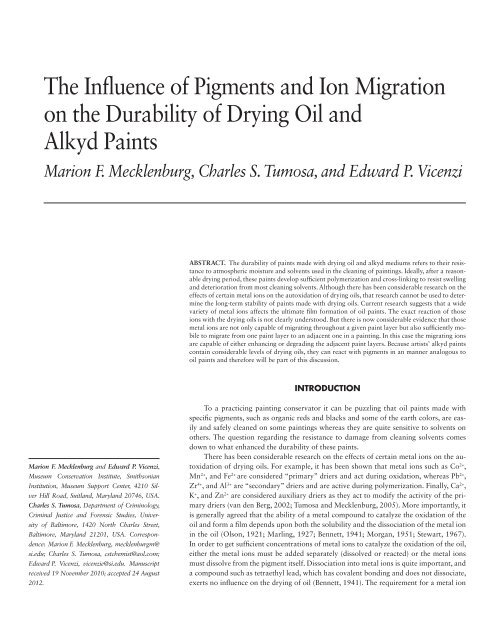Create successful ePaper yourself
Turn your PDF publications into a flip-book with our unique Google optimized e-Paper software.
The Influence <strong>of</strong> Pigments and Ion Migration<br />
on <strong>the</strong> Durability <strong>of</strong> Drying Oil and<br />
Alkyd Paints<br />
Marion F. Mecklenburg, Charles S. Tumosa, and Edward P. Vicenzi<br />
Abstract. The durability <strong>of</strong> paints made with drying oil and alkyd mediums refers to <strong>the</strong>ir resistance<br />
to atmospheric moisture and solvents used in <strong>the</strong> cleaning <strong>of</strong> paintings. Ideally, after a reasonable<br />
drying period, <strong>the</strong>se paints develop sufficient polymerization and cross-linking to resist swelling<br />
and deterioration from most cleaning solvents. Although <strong>the</strong>re has been considerable research on <strong>the</strong><br />
effects <strong>of</strong> certain metal ions on <strong>the</strong> autoxidation <strong>of</strong> drying oils, that research cannot be used to determine<br />
<strong>the</strong> long-term stability <strong>of</strong> paints made with drying oils. Current research suggests that a wide<br />
variety <strong>of</strong> metal ions affects <strong>the</strong> ultimate film formation <strong>of</strong> oil paints. The exact reaction <strong>of</strong> those<br />
ions with <strong>the</strong> drying oils is not clearly understood. But <strong>the</strong>re is now considerable evidence that those<br />
metal ions are not only capable <strong>of</strong> migrating throughout a given paint layer but also sufficiently mobile<br />
to migrate from one paint layer to an adjacent one in a painting. In this case <strong>the</strong> migrating ions<br />
are capable <strong>of</strong> ei<strong>the</strong>r enhancing or degrading <strong>the</strong> adjacent paint layers. Because artists’ alkyd paints<br />
contain considerable levels <strong>of</strong> drying oils, <strong>the</strong>y can react with pigments in an manner analogous to<br />
oil paints and <strong>the</strong>refore will be part <strong>of</strong> this discussion.<br />
INTRODUCTION<br />
Marion F. Mecklenburg and Edward P. Vicenzi,<br />
Museum Conservation Institute, Smithsonian<br />
Institution, Museum Support Center, 4210 Silver<br />
Hill Road, Suitland, Maryland 20746, USA.<br />
Charles S. Tumosa, Department <strong>of</strong> Criminology,<br />
Criminal Justice and Forensic Studies, University<br />
<strong>of</strong> Baltimore, 1420 North Charles Street,<br />
Baltimore, Maryland 21201, USA. Correspondence:<br />
Marion F. Mecklenburg, mecklenburgm@<br />
si.edu; Charles S. Tumosa, cstchemist@aol.com;<br />
Edward P. Vicenzi, vicenzie@si.edu. Manuscript<br />
received 19 November 2010; accepted 24 August<br />
2012.<br />
To a practicing painting conservator it can be puzzling that oil paints made with<br />
specific pigments, such as organic reds and blacks and some <strong>of</strong> <strong>the</strong> earth colors, are easily<br />
and safely cleaned on some paintings whereas <strong>the</strong>y are quite sensitive to solvents on<br />
o<strong>the</strong>rs. The question regarding <strong>the</strong> resistance to damage from cleaning solvents comes<br />
down to what enhanced <strong>the</strong> durability <strong>of</strong> <strong>the</strong>se paints.<br />
There has been considerable research on <strong>the</strong> effects <strong>of</strong> certain metal ions on <strong>the</strong> autoxidation<br />
<strong>of</strong> drying oils. For example, it has been shown that metal ions such as Co 2+ ,<br />
Mn 2+ , and Fe 2+ are considered “primary” driers and act during oxidation, whereas Pb 2+ ,<br />
Zr 4+ , and Al 3+ are “secondary” driers and are active during polymerization. Finally, Ca 2+ ,<br />
K + , and Zn 2+ are considered auxiliary driers as <strong>the</strong>y act to modify <strong>the</strong> activity <strong>of</strong> <strong>the</strong> primary<br />
driers (van den Berg, 2002; Tumosa and Mecklenburg, 2005). More importantly, it<br />
is generally agreed that <strong>the</strong> ability <strong>of</strong> a metal compound to catalyze <strong>the</strong> oxidation <strong>of</strong> <strong>the</strong><br />
oil and form a film depends upon both <strong>the</strong> solubility and <strong>the</strong> dissociation <strong>of</strong> <strong>the</strong> metal ion<br />
in <strong>the</strong> oil (Olson, 1921; Marling, 1927; Bennett, 1941; Morgan, 1951; Stewart, 1967).<br />
In order to get sufficient concentrations <strong>of</strong> metal ions to catalyze <strong>the</strong> oxidation <strong>of</strong> <strong>the</strong> oil,<br />
ei<strong>the</strong>r <strong>the</strong> metal ions must be added separately (dissolved or reacted) or <strong>the</strong> metal ions<br />
must dissolve from <strong>the</strong> pigment itself. Dissociation <strong>into</strong> metal ions is quite important, and<br />
a compound such as tetraethyl lead, which has covalent bonding and does not dissociate,<br />
exerts no influence on <strong>the</strong> drying <strong>of</strong> oil (Bennett, 1941). The requirement for a metal ion
















